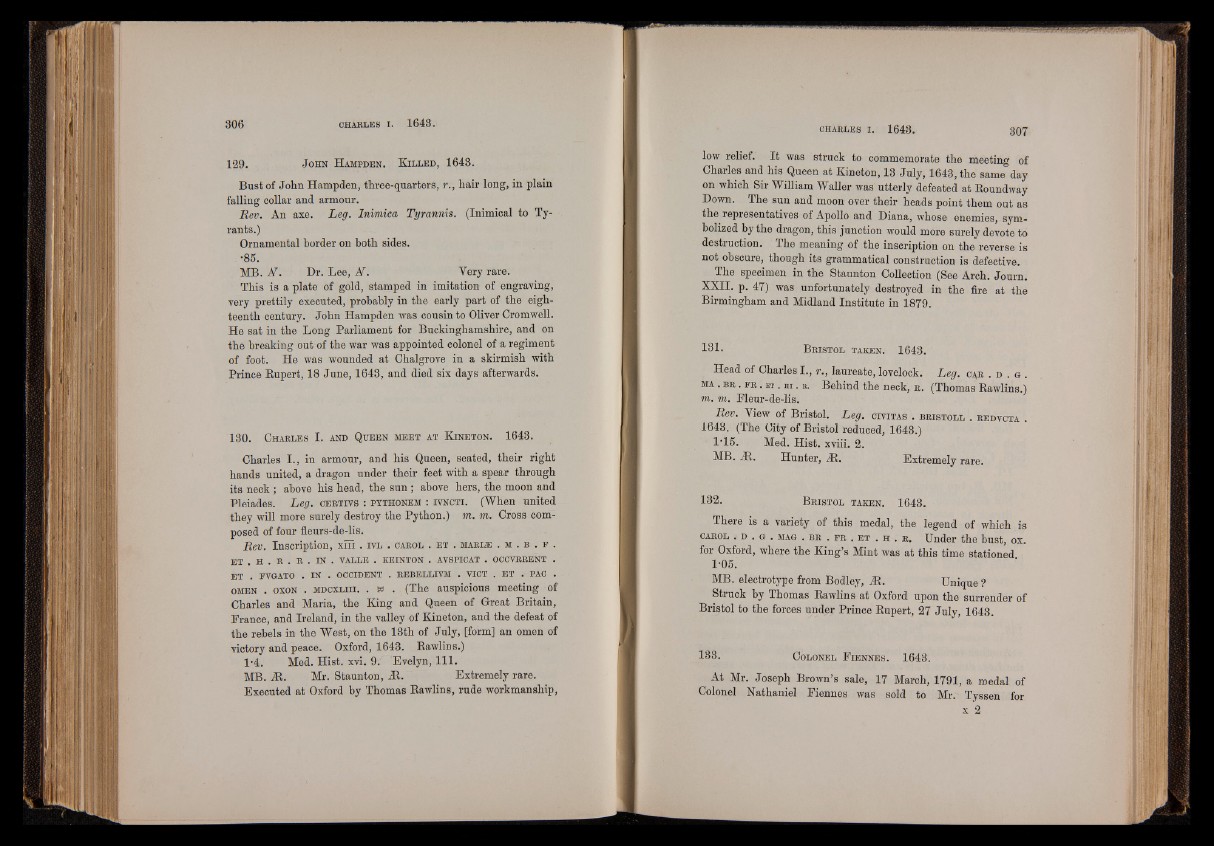
129. J o h n H am pd en . K il l e d , 1643.
Bust of John Hampden, three-quarters, r., hair long, in plain
falling collar and armour.
Rev. An axe. Leg. Inimica Tyrannis. (Inimical to Tyrants.)
Ornamental border on both sides.
•85.
MB. V* Dr. Lee, AL Very rare.
This is a plate of gold, stamped in imitation of engraving,
very prettily executed, probably in the early part of the eighteenth
century. John Hampden was cousin to Oliver Cromwell.
He sat in the Long Parliament for Buckinghamshire, and on
the breaking out of the war was appointed colonel of a regiment
of foot. He was wounded at Chalgrove in a skirmish with
Prince Rupert, 18 June, 1643, and died six days afterwards.
130. C h a r l e s I. and Q u e e n m e e t at K in e t o n . 1643.
Charles I., in armour, and his Queen, seated, their right
hands united, a dragon under their feet with a spear through
its neck ; above his head, the sun ; above hers, the moon and
Pleiades. Leg. c e r t iv s : py t h o n em : iv n c t i . (When united
they will more surely destroy the Python.) to. to. Cross composed
of four fleurs-de-lis.
Rev. Inscription, xin . iv l . carol . e t . m ar i* . m . b . f .
ET . H . R . R . IN . VALLE . KB INTON . AVSPICAT . OCCVRRENT .
ET . FVGATO . IN . OCCIDENT . REBELLIVM . VICT . ET . PAC .
omen . oxon . MDCXLin. . w . . (The auspicious meeting of
Charles and Maria, the King and Queen of Great Britain,
France, and Ireland, in the valley of Kineton, and the defeat of
the rebels in the West, on the 13th of July, [form] an omen of
victory and peace. Oxford, 1643. Rawlins.)
1‘4. Med. Hist. xvi. 9.' Evelyn, 111.
MB. At. Mr. Staunton, At. Extremely rare.
Executed at Oxford by Thomas Rawlins, rude workmanship,
low relief. It was struck to commemorate the meeting of
Chailes and his Queen at Kineton, 13 July, 1643, the same day
on which Sir William Waller was utterly defeated at Roundway
Down. The sun and moon over their heads point them out as
the representatives of Apollo and Diana, whose enemies, symbolized
by the dragon, this junction would more surely devote to
destruction. The meaning of the inscription on the reverse is
not obscure, though its grammatical construction is defective.
The specimen in the Staunton Collection (See Arch. Journ.
XXII. p. 47) was unfortunately destroyed in the fire at the
Birmingham and Midland Institute in 1879.
1 8 1 . B r is t o l t a k e n . 1643.
Head of Charles I . , r . , laureate, lovelock. Leg. C4 R . d . g .
M A . B R . F R . ET . H I . B. Behind the neck, r . (Thomas Rawlins.)
to. to. Fleur-de-lis.
Rev. View of Bristol. Leg. c iv ita s . b r is t o l l . r ed v c ta .
1643. (The City of Bristol reduced, 1643.)
1‘15. Med. Hist, xviii. 2.
MB. At. Hunter, At. Extremely rare.
182. B r is t o l ta k e n . 1643.
There is a variety of this medal, the legend of which is
CAROL . d . o . MAG . b r . f r . e t . h . r . Under the bust, ox.
for Oxford, where the King’s Mint was at this time stationed
1-05.
MB. electrotype from Bodley, At. Unique ?
Struck by Thomas Rawlins at Oxford upon the surrender of
Bristol to the forces under Prince Rupert, 27 July, 1643.
183. C o lo n e l F ie n n e s . 1643.
At Mr. Joseph Brown’s sale, 17 March, 1791, a medal of
Colonel Nathaniel Fiennes was sold to Mr. Tyssen for